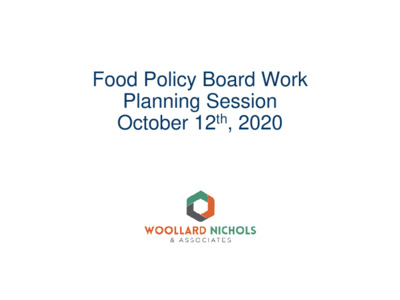Backup_Item2c_KellyNichols_ATCFPB Strategic Planning_20201012 — original pdf
Backup

Food Policy Board Work Planning Session October 12th, 2020 Our Agenda ● Welcome, Objectives, & Meeting Norms ● Opening Conversation Circle: Board Dynamics ● Overview of Focus Group Results and Q&A ● Personal Reflection: What are the tensions inherent in the board’s work? ● Conversation Circle: What are your top one or two priorities for the board for the coming fiscal year? ● Closing Objectives • Share insights from focus groups with board members • Prioritize key focus areas and other feedback to inform FY20- 21 work plan Proposed Meeting Agreements ● Be present & engaged ● Share the space; speak up, hold back ● Avoid assumptions, ask questions ● Be open to learning ● Expect unfinished business ● Define acronyms ● Utilize conversation circle approach Conversation Circle Alejandra Rodriguez Boughton Sharon Mays Andrea Abel Ryan Rosshirt Karen Magid Kara Prior Ellen Sweets Felipe Camacho Emily DeMaria Nicola Joi Chevalier Kacey Hanson Joy Casnovsky Template by Training for Change Opening Conversation Circle ● S = Separateness: the amount of diversity in perspective, expertise, and background among group members ● T = Tuning: the level of listening deeply, reflecting, and making sense of challenges together ● A = Action: the number of opportunities to act on ideas or innovate with group members ● R = Reason to work together: the benefits that are gained from working together Which of the four categories do you think the board is weakest in? Conversation Circle Alejandra Rodriguez Boughton Sharon Mays Andrea Abel Ryan Rosshirt Karen Magid Kara Prior Ellen Sweets Felipe Camacho Emily DeMaria Nicola Joi Chevalier Kacey Hanson Joy Casnovsky Template by Training for Change Focus Group Results 5 Year Headlines ● Austin Voters Pass Local Food Bond Setting the Stage for Major Investment in Local Food System Transformation ● Food Policy Board Spurs Innovation in the Local Food System, Figures out Way Around the ‘Good Ol’ Boy Food Network’ ● Food Policy Board Disbanded Due to Effective Infiltration of Food Into All of the Spaces Where it Needs to be Discussed ● City Creates Department Focusing on Food and Water ● City and County Make Food a Priority in Annual Budgets ● Austin/Travis County Policymakers Know it’s About Food, But it’s Not Really About Food ● Austin and Travis County Understand Joint Connections in Food System… What Happens in Austin Impacts Travis County and Beyond Strongly Agree Agree Disagree Strongly Disagree Agree more than disagree Disagree more than agree 1 Poll Questions Often decisions of the board are made in advance and simply confirmed by the process. The board decision making process responds fairly to the needs of its members. In the board’s decision making process, everyone has an equal opportunity to influence decisions. The people involved in the board’s decision making process usually are focused on broader goals, rather than individual agendas. 1 3 2 4 3 2 4 1 3 4 2 3 2 1 Board Member Reasons for Participating • Had previously participated in a • Was invited by a policymaker to working group participate • Thought my perspective was important on the board • Had previously been a representative from my organization and wanted to continue the organization’s connection to the board • Wanted to connect my organization to the board • Personal connection to the issue/lived experience • Wanted to make changes in local food policy Board’s Biggest Accomplishment or Win • Visibility/awareness of the board – seen as local thought leaders on food • COVID response work • $400,000 that city council invested in healthy food access • Food pantry permitting • Connections with other boards and commissions • Mobile Markets & Fresh 4 Less program • Food & climate work • Developing FY20 city budget recommendations (even though they didn’t result in funding) Working Groups – What’s Working Well? • Have made progress in advocacy outcomes • Level of participation on work groups (# of people engaged) • Community members who participate in working groups tend to be well prepared for board participation • Diversity of background and perspective in working group • Having a clear and specific focus or charge (at least one at a participation time) • Strong relationships with the department whose purview is over the issue the working group is focusing on • Strategic planning for specific work groups • Sharing working group chair responsibilities • Videoconference meetings for work groups aids in accessibility Working Groups – What’s Not Working Well? ● Only having one board member on a working group ● Reactionary instead of proactive approach ● Large group size is a lot of work to facilitate ● Working groups having working groups ● Clarity about scope and focus (sometimes) ● If there’s an issue that doesn’t have a working group, it usually falls through the cracks ● Lack of relationship with the department who purview is over the issue the working group is focusing on ● Engaging harder-to-engage voices (e.g. farmers) Working Groups – other observations ● Some working groups seems to have largely professionals; others have more community members. Pros and cons of both. ● Sharing wins, lessons learned, tips and tricks across working groups ● Having “standard operating procedures” for work groups could be would be useful useful Suggested Areas of Focus/Prioritization Board Engagement External Engagement Evaluation Coordination Resources Action/Advocacy Q&A Personal Reflection What are the tensions inherent in the board’s work? See if you can come up with one or more “wicked questions” about the board’s work together in the following format: “How is it that we are ____ and we are ____ at the same time?” Circle Conversation What are your top one or two priorities for the board for the coming fiscal year? Conversation Circle Alejandra Rodriguez Boughton Sharon Mays Andrea Abel Ryan Rosshirt Karen Magid Kara Prior Ellen Sweets Felipe Camacho Emily DeMaria Nicola Joi Chevalier Kacey Hanson Joy Casnovsky Template by Training for Change One word that describes how you’re leaving this Closing conversation